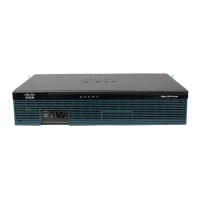31
Cisco 3900 Series, Cisco 2900 Series, and Cisco 1900 Series Integrated Services Routers Generation 2 Software Configuration Guide
Chapter Configuring Ethernet CFM and Y.1731 Performance Monitoring on Layer 3 Interfaces
Configuring a Network Interface Device on the L3 Interface
Router>enable
Router#configure terminal
Router(config)#interface gigabitethernet 0/2
Router(config-if)#port-tagging
Router(config-if-port-tagging)#encapsulation dot1q 10
Router(config-if-port-tagging)#set cos 6
Router(config-if-port-tagging)#end
Verifying the NID Configuration
Use the following commands to verify the port tagging sessions:
• show run int
• ping
Use the show run int command to display the port tagging sessions:
Router#show run int gi0/2
Building configuration...
Current configuration : 10585 bytes
!
interface GigabitEthernet0/2
no ip address
duplex auto
speed auto
port-tagging
encapsulation dot1q 10
set cos 6
exit
end
!
interface GigabitEthernet0/2.1101
encapsulation dot1Q 100
ip address 132.1.101.4 255.255.255.0
!
interface GigabitEthernet0/2.1102
encapsulation dot1Q 100
ip address 132.1.102.4 255.255.255.0
!
Use the ping command to verify the connectivity with port tagging configured:
Router#ping 132.1.101.3
Type escape sequence to abort.
Sending 5, 100-byte ICMP Echos to 132.1.101.3, timeout is 2 seconds:
!!!!!
Success rate is 100 percent (5/5), round-trip min/avg/max = 1/1/4 ms
router#
Troubleshooting the NID Configuration
Table 1 lists the debug commands to troubleshoot the issues pertaining to the NID functionality.
The Cisco IOS Master Command List at
http://www.cisco.com/en/US/docs/ios/mcl/allreleasemcl/all_book.html provides more information
about these commands.

